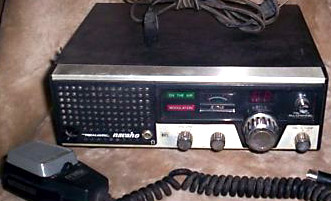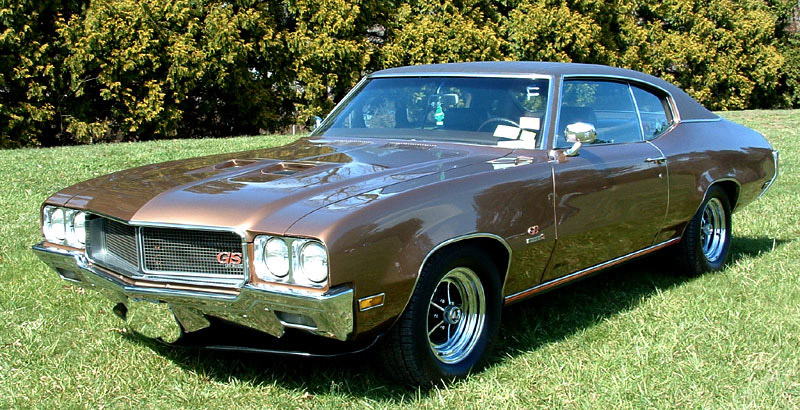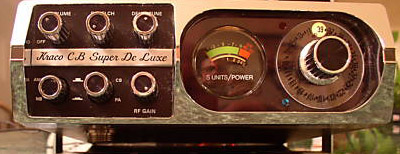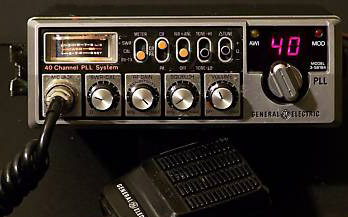CB Radio
KBRL7970
| SBE Console 5 | Midland 77-861 | Cherokee Night Rider | Cherokee AH-27 |
| Midland WT 75-820 | Radio Shack TRC-241 | Freebanding | Uniden Washington |
| Hooking up A Mobile | Hooking up A Base | CB Radio Links | Walkie Talkies |
This was the original general purpose, two way radio, for the casual user. The service, technically known as class D radio, originally had only 23 channels. The intention of the service was to provide a band on which non technical, non hobbyist users could enjoy two way communications, with comparatively simple and inexpensive equipment. This is in contrast to the ham radio service, put in place to permit the pursuit of the radio hobby, and encourage the formation of a cadre of expert radio enthusiasts. The frequencies used were at the top of the short wave bands, in what had been the 11 meter ham radio band. This band was chosen after failure of the higher frequency CB class A and B radios. These higher frequency radios had been proposed in 1945, when it was determined that a public, non hobbyist radio service would be a desirable thing to have. Technical issues, regarding high frequency transmission, and FM mode of service, made these too expensive, and difficult to produce, to make their use practical for this grade of service. Advances in technology reached a point where in the mid 70's an attempt was made to introduce a VHF citizen's band service on part of the 220 (1.25 meter) ham band. It was rejected. The idea has been successfully reintroduced with the FRS units, which today's more advanced technology makes possible, and inexpensive.
Like most boys growing up in the sixties,
I went through several sets of walkie talkies. These were low powered units, putting
out 100mw. They had extensible antennas, and a combination speaker/mike.
As a paperboy, at the advanced age of 12 or 13, I saved up to get myself a "good"
unit. Actually, I got a pair of good units. These were G.E. walkie
talkies, which could broadcast on three channels (though crystals were
included for only one), and put out 2 watts. As such, they had to be licensed,
which I meant to do, but somehow never did. Later on, I got an even better
unit, a Radio Shack five watt, 40 channel walkie talkie, with a base loaded
antenna, and a separate speaker and mike. This was right up there with my
microscope, and telescope, vying for the honor of being my prize possession.
During my teen age years, my first car, also had my first mobile CB. This was a
40 channel Kraco unit, with an antenna mounted on the lip of the trunk.
Up to this day, I have never owned a car, in which I did not install a
CB. 
I would eventually have a base station, and then a second base, a bit better than the first. I actually licensed my first base, and received that call sign KBRL7970. About two months after I paid my fee, and got my license, the requirement for licensing was dropped. These base units would be followed by a portable CB, and were preceded and followed by a number of full power walkie talkies. The first base was a Radio Shack TRC-431, which used one of those horrible back of the set antennas. It actually got out all right; but the 40 channel walkie talkie that I also owned at the time, got out much better, probably because of its far better 48" antenna. I was really impressed with the "On The Air" light, which would come on, whenever the mike was keyed. I lived in a a town house at the time, with a second floor, and a flat roof. Eventually I got myself an antenna mast, and a Starduster antenna, and put it up. This improved things to an incredible degree, and I found that I could get all over the city, from the Lake, to the suburbs. I eventually got myself a better base - an SBE Console V, and hooked it to my new antenna. The Radio Shack base would end up on my boat. Still, though the base units were fun, the real magic of CB was in going mobile.
Antennas, for the mobile
units, tended to be magnetic mounts, stored in the trunk, having their coax
cables run under the carpets of the various vehicles in which they were installed. My first car was a 1970 Buick GS 455 - this was in
the mid seventies. This also had my first mobile CB radio. With this car, my 40
Channel CB, and a full tank of gas, the road was truly my mistress. I was in
teen aged heaven. The GS was a genuine muscle car, and one of the fastest cars
ever built. Though I did not realize it at the time, this would become so
stereotypical, as to be almost an icon of the seventies - a muscle car with a CB
radio.
which they were installed. My first car was a 1970 Buick GS 455 - this was in
the mid seventies. This also had my first mobile CB radio. With this car, my 40
Channel CB, and a full tank of gas, the road was truly my mistress. I was in
teen aged heaven. The GS was a genuine muscle car, and one of the fastest cars
ever built. Though I did not realize it at the time, this would become so
stereotypical, as to be almost an icon of the seventies - a muscle car with a CB
radio.
That Kraco CB was
one of the first of the 40 channel units, and like most of them, greatly
resembled the older style 23 channel units. Though designers were busy coming
up with the newer style 40 channel units, with the new LED digital displays, the
market was
 so
hot for CB radios, that every day spent waiting to get a product to market,
meant huge amounts of money lost. So most companies slightly rebuilt the insides
of their existing stocks of 23 channel radios, and shipped them off, to be
bought as quickly as they could be delivered. The radio sounded good, had a
number of features, and I enjoyed just sitting in my car, parked, and using the
CB. The radio was offered at a low price, of around $100, and included an
antenna. This was an attempt to clear it out, in preparation for the upcoming
introduction of the new digital models. The radio, and car, would serve me for
several years, before both were stolen. I would soon after get another Buick,
also with a 455 engine; but this would be a big four door luxury Buick boat(an
Electra Limited), for which I would get my first digital display mobile - a G.E.
5819. Like that first set of good walkie talkies, this radio would be purchased
through my uncle, who
so
hot for CB radios, that every day spent waiting to get a product to market,
meant huge amounts of money lost. So most companies slightly rebuilt the insides
of their existing stocks of 23 channel radios, and shipped them off, to be
bought as quickly as they could be delivered. The radio sounded good, had a
number of features, and I enjoyed just sitting in my car, parked, and using the
CB. The radio was offered at a low price, of around $100, and included an
antenna. This was an attempt to clear it out, in preparation for the upcoming
introduction of the new digital models. The radio, and car, would serve me for
several years, before both were stolen. I would soon after get another Buick,
also with a 455 engine; but this would be a big four door luxury Buick boat(an
Electra Limited), for which I would get my first digital display mobile - a G.E.
5819. Like that first set of good walkie talkies, this radio would be purchased
through my uncle, who could get them at a special price, due to being a G.E. employee. I went the
whole hog on this one, getting a top of the line magnet mount antenna, and
hooking up the PA speaker, which ended up being almost as much fun as the radio
itself. The newer technology of the G.E. radio put it head and shoulders above
the old Kraco unit that I had formerly possessed.
could get them at a special price, due to being a G.E. employee. I went the
whole hog on this one, getting a top of the line magnet mount antenna, and
hooking up the PA speaker, which ended up being almost as much fun as the radio
itself. The newer technology of the G.E. radio put it head and shoulders above
the old Kraco unit that I had formerly possessed.
During the sixties, and into the early seventies, CB had been for kids with walkie talkies, gadget freaks, people who liked radios, and wannabe ham radio operators who could not pass the ham radio tests. There were also a few business users, and a few casual users like hunters and other sportsmen. In the mid seventies, this all changed. It started with the truck drivers, and many attribute the sudden popularity of CB to the oil embargo of 1973, and the subsequent 55 MPH speed limit. These may have added to it; but I think it was also a matter of all of those boys who had played with walkie talkies in the sixties, suddenly being grown up and buying cars. The equipment also got quite a bit cheaper, and quite a bit more capable. With PLL circuitry, a 40 channel unit could be compact, and only needed a few crystals to generate all of its operating frequencies. Previously, two crystals were required for every channel.
In 1977, the FCC authorized an increase from the original 23 channels, to 40 channels, largely in an attempt to help reduce congestions of the band. This was also when the requirement for licensing was dropped, along with the need to pay a $20 fee. By 1980, most new radios had gone to digital channel display. The whole thing became a social phenomena, and everyone had a CB radio. There were CB chat rooms, and CB clubs, as well as CB nets. This was, technically not legal, as CB was supposed to be for non radio hobby use; but with so many users, the regulations were getting impossible to enforce. I remember working as a bartender in the early eighties, and after work, around 3:00 - 4:00 in the morning, I would get in my car, and turn on the CB, and there would be people talking. It was just incredibly popular - too much so.
From an original user base of around 800,000, in the late sixties/early seventies, by 1977, there were over 9,000,000 applications for licenses, and who knows how many unlicensed users. This was the year the the FCC stopped issuing licenses and charging fees. It also seems to be the year that they simply gave up on CB, and let users do as they wished. This was probably the start of the decline, though it would not become really noticeable for a few years. By the late seventies/early eighties, I actually had some "Extra" CB radios laying around, including an extra base, and an extra mobile with a power supply. I left one at my brother's apartment, and another at a friend's house, and actually did find a way to get some use out of them, despite all of the congestion on the bands.
I put up a second antenna. This was a horizontal dipole, which is a bit different from the standard vertical whip used by most CBs. Being a horizontal antenna, these dipoles were polarized differently from the vertical antennas which are standard in CB. The different polarization creates a 20 db difference. This acts as a a kind of a filter, for two stations being so configured. A difference of 20db, is a bit more than the difference between putting out 1 watt (very low), and 100 watts (very illegal). So while communicating in this manner, we would have a 20 db advantage over other units on the same frequency. What makes this really interesting, is that it works both ways. To the regular users, having vertical antennas, we seemed to have a 20 db disadvantage. It was almost like having our own set of channels, and we would joke about these being the H channels, so that using a horizontal antenna on channel 32, was using channel 32H.
Many of the old guard of hobbyists, got out of CB, because it was getting too crowded, and too crazy. Linear amplifiers were common, as was out of band broadcasting, and a complete lack of adherence to established protocol. This also discouraged many new users, who got themselves a radio, and then found the bands almost unusable. Soon enough, cell phones, the new FRS, and other alternate radio services were available. It may also be that the boomers just plain outgrew the novelty of CB radios, and then went on the the next thing, which would turn out to be computers, and the internet. So the numbers dropped almost as quickly as they rose, and large numbers of CB radios ended up in attics, dumpsters, garages, or as permanent residents in car trunks.
For a while, CB gear was getting pretty inexpensive, due to large production numbers, and long production runs. There were also really no development costs, as it was a very mature technology. Now this is changing a bit, as CB has lost much of its popularity. Older units are getting harder to find, in working condition, and there are no longer very many companies offering new units.
Present day use of CB and comparison to FRS
CB is still around, though it is just a shadow of its former self. It has been eclipsed on the road by cell phones, and everywhere else by the new cheaper, smaller, FM mode FRS and GMRS radios. Still, it is not without merit. Truck drivers, woodsmen, and outdoor enthusiasts still use CB, as do a number of hobbyists. The reason for this is the range, and potential of what is an HF band. For local contact, A CB base can reach thirty miles or more, and a mobile can reach five to ten. I don't care what the advertisements say, no FRS radio will ever achieve anywhere near that range.
CB also offers forty channels, SSB on some units, and eight times the power of FRS radios (though it only has about a tenth the power of GMRS units). It also offers true long distance communication when atmospherics allow for skip. All of this is offered on a service which required no license, and a minimum outlay of cash. So it seems that CB has returned to its roots, with the same numbers and types of users that it had when I was a small boy playing with my walkie talkies. It feels just like the old days again. And they say you can never go back.
The CB Channels
Class D transmissions
are permitted on the following frequencies.
2. 26.975 16. 27.155 29. 27.295
3. 26.985 17. 27.165 30. 27.305
4. 27.005 18. 27.175 31. 27.315
5. 27.015 19. 27.185 32. 27.325
6. 27.025 20. 27.205 33. 27.335
7. 27.035 21. 27.215 34. 27.345
8. 27.055 22. 27.225 35. 27.355
9. 27.065 23. 27.255 36. 27.365
10. 27.075 24. 27.235 37. 27.375
11. 27.085 25. 27.245 38. 27.385
12. 27.105 26. 27.265 39. 27.395
13. 27.115 27. 27.275 40. 27.405
14. 27.125